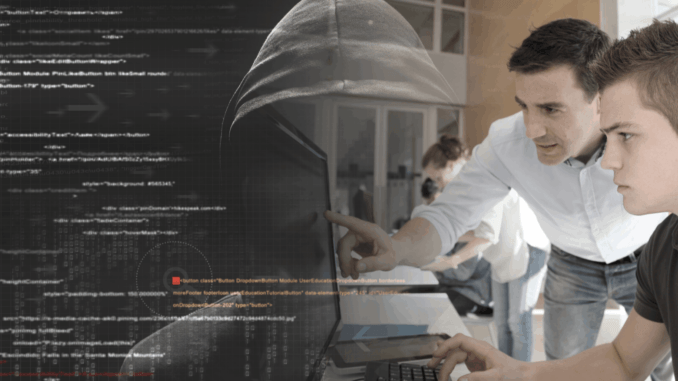
The year 2018 marked a very important milestone for our company, Gravic, Inc. We hosted our first-ever hackathon, and it was a major success. After months of planning, scheduling, coordination, and approval, we successfully hosted what has now become a highly anticipated annual event.
What do you think a hacker is?
What comes to mind when you hear the word hacker? You most likely imagine an individual, (probably male) with elite technical prowess and malicious intent, hunched over a set of bright computer screens streaming Matrix-like green text on a black background in a poorly-lit basement, stealing innocent people’s credit card information. Or perhaps, he is an Internet troll with the desire and ability to bring down a massively popular website. Soon, you will see how this antiquated version of the word hacker has evolved into innovative events happening at higher-level educational institutions, dynamic user communities, and forward-thinking companies all over the globe.
A brief history of hacking
The term hacking originated at MIT in 1955, vaguely meaning, “to work on something.” Over the years, the term became popular, but obscured through various alternative uses. It was not until the 1960s that hacking became more commonly associated with computers and technology. The concept of a black-hat hacker emerged in 1963, similar to the one described above. MIT’s student newspaper reported on a series of hacks on local phone lines, and this negative connotation lasted for decades.¹ Today, we see a resurgence of the original meaning of hack: to create innovative solutions to problems using tools and skills at your disposal. In fact, this term has caught on so fiercely that an entire hacker culture has emerged, initiating a series of events called hackathons.²
Hackathons and hacker culture
Hacker culture is about collaborating, learning new information, solving problems, and building interesting contraptions and apps. Hackathons exemplify these ideas in 8, 12, 24, or possibly 36-hour sessions, pitting curious and energetic minds against some of the world’s biggest problems and opportunities. Participants form teams based on their interests, skills, and goals, and then they hack (e.g., write code, solder wires, design user interfaces, or create new processes). All hackers have one goal: make a Minimum Viable Product (MVP) to demonstrate to the judges their vision and ability. The hackathon organizers provide food, plenty of caffeinated beverages, sleeping space, fun events, and tech talks on new disruptive technologies.
Enterprise adoption
Unsurprisingly, hacker culture and hackathons have made their way into the corporate space as more tech companies see the benefits of hosting such events with their employees. Gravic’s Learning and Development Committee (LDC) recognized this opportunity for employees to work on tasks outside the scope of their job experience and help solve various company issues. However, organizing a hackathon is not trivial: getting approval, educating employees about hackathons, generating hype, leading brainstorming sessions, coordinating two full workdays, allocating office space, and budgeting for food, drinks, and SWAG (Stuff We All Get). Preparing for the hackathon was a hackathon in and of itself!
GravHack2018
GravHack2018 was the first hackathon experience for most Gravians, and they soon learned that participation in a hackathon was not easy. Any worthwhile hackathon project is a mix of technical complexity (how technically impressive and difficult), idea (how conceptually innovative, creative, and interesting), and impact (how well it solves the problem). Deciding on a project that encompasses all three categories is challenging. As a committee, we launched a company-wide campaign to generate project ideas in the weeks leading to the event. We established methods to submit ideas online and in person, and a way to showcase the ideas so that employees could peruse them for inspiration and also receive public acknowledgement for their submissions. We then culled down the list of ideas and formed teams based on project interest.
The challenges did not stop there. Fast forward to when hacking began: we had teams and ideas, we just needed to start working. “Quick, install and configure the software we need!” “Okay, let’s get a repo [code repository] set up!” “Who in the group is familiar with this technology? No one? OK, we need to figure this out.” “When is the food going to get here?” Hours passed, with increasing time pressure. “Why doesn’t this work? The documentation is wrong. We have how much time until demos?”
To mark the end of the hackathon, give recognition to the teams, and learn the results, we invited the entire company to a happy hour. Participants presented their projects and findings, and earned awards based on project categories and memorabilia.
The resulting hacks were both interesting and diverse:
- CoffeeCam – a web app where employees could quickly check the coffee level in the kitchen’s pots using a raspberry pie, a camera, and an image processing algorithm
- Company SWAG – unique company trinkets to distribute at trade shows and how to more effectively interact with attendees at the booth
- Internal Knowledgebase – automatically scan documentation and convert it to markdown, displayable in a user interface
- LLVM Back-end – generate TNS/E or TNS/X executables for HPE NonStop
- Outlook Meeting Notifications – a better reminder window that appears at the exact time of a meeting
- ShadFish – a chess game where Shadowbase software competes against itself using a chess algorithm library and a web app
- Shadowbase Config GUI – a Shadowbase configuration generator GUI to ease the config generation process
Management was deeply impressed with the results; however, not just the MVP’s themselves, but with the fact that the participants still talk about their projects and bounce ideas off of each other, in anticipation of the next hackathon. Participants enjoyed a tremendous experience, were exposed to new ideas and ways to solve problems, and learned some exciting concepts.
Organize a hackathon!
Why not host a hackathon at your company? Hackathons promote creativity, ingenuity, critical thinking, and teamwork; and better yet, you do not need to be technically inclined or skilled to participate. Wherever and whoever you are, you probably have some problems or process inefficiencies at your company – a tool or procedure that may be ineffective, slow, or cumbersome. Speak up, organize a group of employees, add some caffeine, and hack away!
¹ Source: A 125-Year-Old Letter Dives Into the True Meaning Of the Word Hack
² Source: A Short History of “Hack”






Be the first to comment